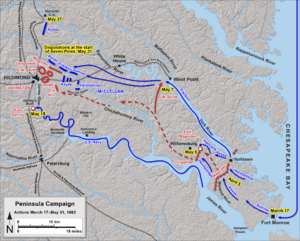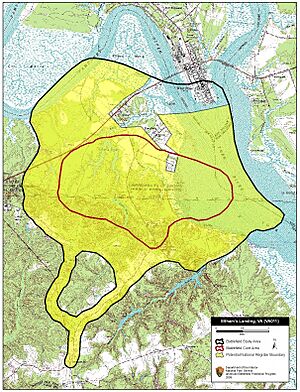Battle of Eltham's Landing facts for kids
Quick facts for kids Battle of Eltham's Landing |
|||||||
|---|---|---|---|---|---|---|---|
| Part of the American Civil War | |||||||
 Battle of Brickhouse Point or Eltham's Landing, May 7, 1862 |
|||||||
|
|||||||
| Belligerents | |||||||
| Commanders and leaders | |||||||
| William B. Franklin | G. W. Smith William H. C. Whiting |
||||||
| Strength | |||||||
| 11,300 | 11,000 | ||||||
| Casualties and losses | |||||||
| 194 | 48 | ||||||
The Battle of Eltham's Landing happened on May 7, 1862. It is also known as the Battle of Barhamsville or West Point. This fight took place in New Kent County, Virginia, during the American Civil War.
It was part of a bigger plan called the Peninsula Campaign. Union General William B. Franklin's troops landed at Eltham's Landing. They were attacked by Confederate soldiers led by General G. W. Smith. The Confederates wanted to protect their supply wagons on the Barhamsville Road. Even though Franklin's troops landed, they couldn't stop the Confederate army from moving away.
Why the Battle Happened
Confederate General Joseph E. Johnston surprised everyone by leaving his defenses at Yorktown. This happened on the night of May 3, 1862. Union General George B. McClellan was not ready to chase him right away.
On May 4, McClellan sent his cavalry to follow Johnston's army. He also sent about half of his Army of the Potomac to support them. These Union troops fought in the Battle of Williamsburg on May 5. After that battle, the Confederates kept moving northwest towards Richmond.
McClellan had another plan. He ordered General William B. Franklin's troops to get on ships. They would sail up the York River to try and cut off Johnston's retreat. It took two days to load all the soldiers and their equipment onto the ships. Because of this, Franklin's troops couldn't help in the Williamsburg battle.
McClellan hoped this water movement would work well. He planned to send more divisions by river after Franklin's. Their goal was Eltham's Landing. This landing was on the south bank of the Pamunkey River. It was across from West Point, a port on the York River. West Point was also the end of the Richmond and York River Railroad. From the landing, it was about 5 miles (8 km) south to Barhamsville. This small town had a key road intersection. Johnston's army was using this road on May 6 to retreat.
Franklin's soldiers came ashore in small, light boats. Then, they built a 400-foot (122 m) long floating dock. They used pontoons, canal boats, and wood for this. This dock helped them unload cannons and supplies. They worked through the night using torches. The only resistance they faced was a few shots from Confederate guards. These shots stopped around 10 p.m.
The Battle
General Johnston told General G. W. Smith to protect the road to Barhamsville. Smith gave this job to General William H. C. Whiting's division. He also sent Hampton's Legion, led by Colonel Wade Hampton.
On May 7, Franklin placed General John Newton's troops in the woods. They were on both sides of the landing road. Two more brigades supported them from behind. These were led by Generals Henry W. Slocum and Philip Kearny.
General John Bell Hood's Texas Brigade moved forward. They pushed back Newton's front line of soldiers. Hampton's troops were on Hood's right side. Hood was worried his men might accidentally shoot each other in the thick woods. So, he told them to advance with their rifles unloaded.
Hood's men met a Union guard line only 15 paces away. Hood later wrote that a Union soldier aimed his rifle at him. Luckily for Hood, a soldier named John Deal had not followed orders. He had a loaded rifle. Deal shot the Union soldier before he could fire.
As a second Confederate brigade followed Hood, the Union troops pulled back. They left the woods and went to the open area near the landing. They sought cover from their own gunboats' fire. Whiting used his cannons against the Union gunboats. But his cannons couldn't shoot far enough. So, he pulled his troops back around 2 p.m. Union soldiers moved back into the woods after the Confederates left. But they did not try to advance any further.
What Happened After
The Battle at Eltham's Landing was mostly a small fight. The Union army had 194 soldiers hurt or killed. The Confederate army had 48. Franklin told McClellan, "I am glad we held our position."
Even though no side truly won, Franklin missed a chance. He could have stopped the Confederate army from retreating from Williamsburg. Instead, they got away without trouble.
General Johnston was happy with how things turned out. He joked with General Hood about his Texans. He asked, "What would your Texans have done, sir, if I had ordered them to charge and drive back the enemy?" Hood replied, "I suppose, General, they would have driven them into the river, and tried to swim out and capture the gunboats."
See also
 In Spanish: Batalla de Eltham's Landing para niños
In Spanish: Batalla de Eltham's Landing para niños



